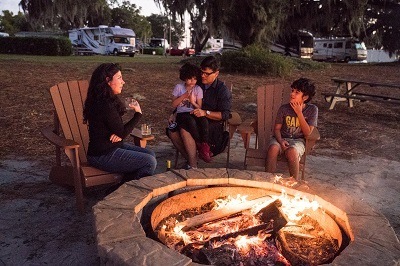
New research released Tuesday by RVIA provides details on campsite and campground availability and amenities at the federal, state, municipal and private levels.
Among the headline findings, RVIA reported, are shortages in full-service hookups; disparities between public and private campground amenities, particularly WiFi access; and a need for more pull-through sites.
RVIA referenced KOA’s 2021 North American Camping Report that found full-service hookups are among the top 10 amenities sought by campers at campgrounds, with 29% of respondents choosing the amenity.
In the new Campground Industry Market Analysis, available to RVIA members by clicking here, only 8% of public campgrounds and 51% of private campgrounds offer full-service hookups.
During peak camping season, June through August, 76% of all campsites are booked, RVIA stated. The result creates difficulties for RVers to find campsites meeting their needs, RVIA stated.

Disparities between public and private campgrounds begin in the number of RV sites available. Private RV campgrounds offer an average of 116 RV sites among 12,118 campgrounds. Public RV campgrounds offer an average of 32 sites among 8,349 campgrounds.
Among all campgrounds, private campgrounds have a longer median length of RV sites, at 60 feet compared with public campgrounds’ median length of 45 feet.
WiFi service is dramatically different between public and private sites, the report found. Only 3% of public campgrounds offer WiFi service compared with 60% of private campgrounds.
Private campgrounds offer nearly double the dump stations (62% compared with 32%) as public campgrounds.
“Altogether, these findings indicate that increasing campsite amenities should be a priority of the campground industry,” RVIA stated, “as this would improve consumers’ overall campsite experience.”
The research found 63% of private RV campgrounds offered RV hookups compared with 61% of public RV campgrounds. Electric hookups were comparable, with 63% of private RV campgrounds offering the service compared with 59% of public RV campgrounds.
However, differences appeared in water (63% private RV campgrounds, 30% public RV campgrounds) and sewer (51% private, 8% public) hookups.
“With the significant influx of new RVers in recent years,” RVIA stated, “the data in the report clearly indicates that both the public and private campground sectors within the ‘Outdoor Hospitality’ industry need to continue to grow, expand, and redevelop their supply of facilities to keep pace with consumer demand, particularly when it comes to providing full hookups and Wi-Fi to meet both current and future needs of RVers.”
RVIA stated the new data will help the association’s government affairs team work with the campground industry and policymakers to address industry challenges.





